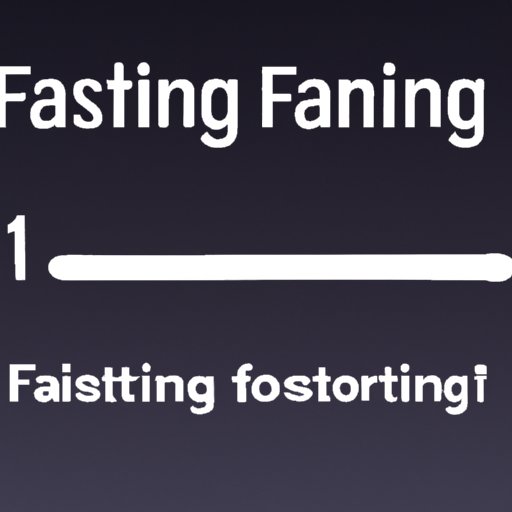
I. Introduction
Fasting, the practice of abstaining from food or drink, is a common practice in many cultures. In recent years, fasting has gained popularity as a health trend with many claimed benefits. But how long can you safely fast? This article examines the benefits and risks of different types of fasting and explores the maximum amount of time you can fast safely.
II. The Benefits and Risks of Fasting for Extended Periods of Time
Fasting can take many forms, including water fasts, juice fasts, and intermittent fasting. While there are potential benefits to fasting, there are also risks associated with extended fasts. One of the most significant risks of fasting is muscle loss, so it’s essential to understand the potential benefits and risks before attempting an extended fast.
Definition of Fasting and Different Types of Fasts
Fasting is the practice of abstaining from food or drink for a set period of time. There are many different types of fasts, including:
- Water fasts: A fast in which only water is consumed
- Juice fasts: A fast in which only fruit or vegetable juices are consumed
- Intermittent fasting: A fast in which you alternate periods of eating with periods of fasting
Potential Benefits of Fasting, Including Improved Brain Function and Weight Loss
There are many potential benefits to fasting, including:
- Improved brain function: Fasting has been shown to increase brain-derived neurotrophic factor (BDNF), a protein that plays a role in brain function and cognitive performance.
- Weight loss: Fasting has been shown to be an effective way to lose weight, as it helps to reduce overall caloric intake.
- Improved insulin sensitivity: Fasting can help to improve insulin sensitivity, which is beneficial for those with type 2 diabetes or insulin resistance.
Risks of Extended Fasting, Including Muscle Loss and Dehydration
While there are potential benefits to fasting, there are also risks. Extended fasting can lead to:
- Muscle loss: During an extended fast, the body begins to break down muscle tissue for energy, which can lead to muscle loss.
- Dehydration: Without food and water intake, it’s essential to ensure proper hydration during a fast.
- Lightheadedness and fatigue: Extended fasting can lead to fatigue and dizziness, making it essential to take time to rest and recover during and after a fast.
III. The Science Behind How Long You Can Safely Fast
So, how long can you safely fast? The answer depends on several factors, such as a person’s overall health, body composition, and the type of fasting they are practicing.
Explanation of How Fasting Affects the Body
Fasting affects the body by reducing insulin levels, causing the body to burn stored fat for fuel. During fasting, the liver breaks down stored glycogen into glucose to provide energy for the body.
Explanation of the Body’s Response to Extended Fasting, Including the Release of Ketones
During an extended fast, the body begins to produce ketones, byproducts of fat metabolism that can be used for energy. Ketones can help to reduce appetite and improve energy levels during a fast.
The Maximum Amount of Time a Person Can Fast Safely
The maximum amount of time a person can fast safely varies depending on a person’s individual health and the type of fast they are practicing. Water fasts should not exceed three days, while juice fasts may be extended up to 10 days. Intermittent fasting can be practiced indefinitely, but it’s important to pay attention to hunger cues and ensure proper hydration.

IV. Tips for Building Up to Longer Fasts
If you’re interested in trying an extended fast, it’s important to build up to it gradually. Here are some tips for getting started:
- Start with intermittent fasting: Begin with shorter periods of fasting, gradually building up to longer fasts.
- Stay hydrated: Proper hydration is essential during fasting. Drink plenty of water and electrolyte-rich fluids.
- Manage hunger: Hunger can be a challenge during fasting. Try distracting yourself with activities or using hunger-controlling supplements.
V. What Happens to Your Body When You Fast for Different Durations
What happens to your body during a fast changes based on the duration of fasting. Here’s a breakdown of what to expect:
Short-Term Fasts (1-3 Days):
During short-term fasts, the body begins to break down glycogen stores and switch to burning fat for fuel. Insulin levels drop, and the body releases ketones to provide energy. Short-term fasts can improve insulin sensitivity and promote weight loss.
Intermediate Fasts (3-5 Days):
During intermediate fasts, the body continues to break down stored glycogen and fat for energy. Hunger subsides, and energy levels improve as the body becomes more efficient at using ketones for fuel. Intermediate fasts can promote weight loss, improve insulin sensitivity, and decrease inflammation.
Long-Term Fasts (5+ Days):
During long-term fasts, the body begins to break down muscle tissue for energy, leading to muscle loss. Ketone production increases, and the body enters a state of ketosis. Long-term fasts can promote weight loss, improve insulin sensitivity, and reduce inflammation but come with an increased risk of muscle loss.
VI. The Psychological Impact of Long-Term Fasting
Long-term fasting can have psychological effects, including:
- Fatigue and lethargy
- Mood changes, including irritability and anxiety
- Difficulty concentrating
It’s important to be mentally prepared before attempting a long-term fast and to listen to your body’s signals to avoid any potential risks to your mental health.
VII. Different Approaches to Fasting, Including Intermittent Fasting and Time-Restricted Eating
While long-term fasting is one approach, it’s not the only way to fast. Here’s a breakdown of other fasting approaches:
Intermittent Fasting:
Intermittent fasting involves alternating periods of eating and fasting, with typical fasting periods lasting between 12-16 hours. Intermittent fasting can promote weight loss, improve insulin sensitivity, and decrease inflammation.
Time-Restricted Eating:
Time-restricted eating involves eating during a specific period, typically between 6-8 hours each day, with the remainder of the day spent fasting. Time-restricted eating can promote weight loss, improve insulin sensitivity, and decrease inflammation.
VIII. Navigating the Potential Side Effects of Extended Fasts
Although extended fasts can have potential benefits, they can also come with side effects, including:
- Nausea and diarrhea
- Dizziness and lightheadedness
- Low blood sugar
- Dehydration
It’s essential to monitor your body and stop fasting if these symptoms become severe. Ensuring proper hydration and replenishing electrolytes can also help to minimize these side effects.
IX. Conclusion
While fasting can have potential benefits, it’s crucial to understand the risks and to approach fasting safely and gradually. Whether it’s trying intermittent fasting or building up to a longer fast, the key is to pay attention to hunger cues, stay hydrated, and listen to your body. The maximum amount of time a person can fast safely varies, but with proper planning and preparation, fasting can be a safe and effective way to improve weight loss and insulin sensitivity.
Advice for Those Considering Extended Fasting
If you’re considering an extended fast, it’s essential to speak with a healthcare provider first. They can help determine if fasting is safe for you and offer guidance on how to approach fasting safely.





